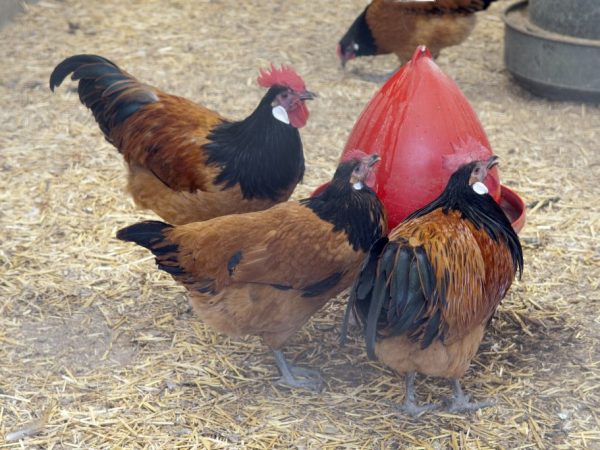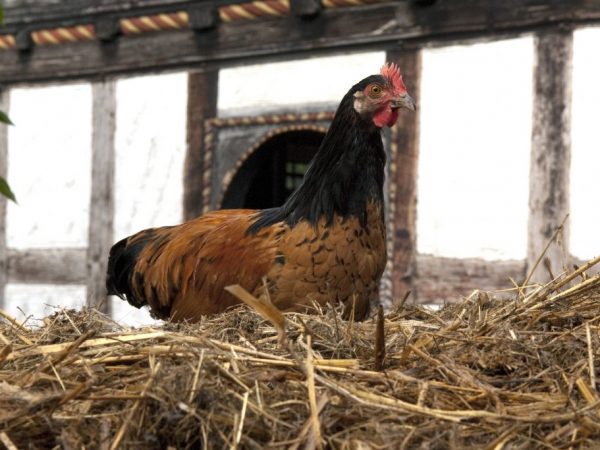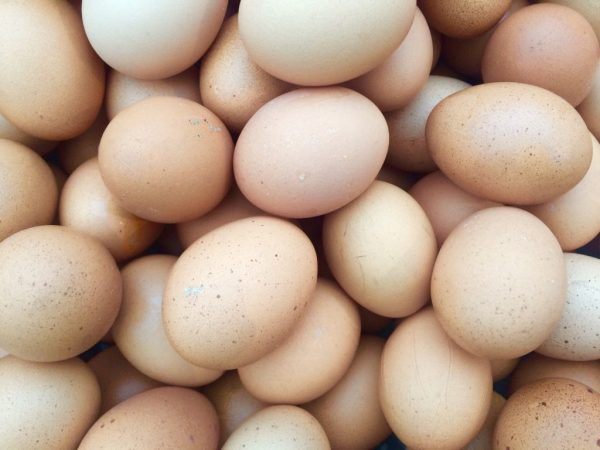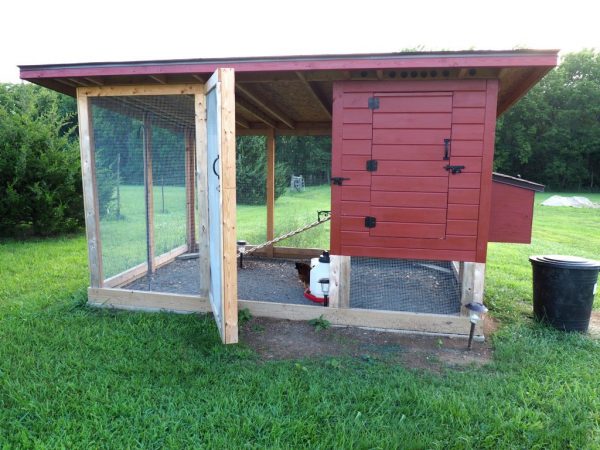Forverk breed - chickens of unusual color
The Forwerk breed of chickens is relatively young, it was registered at the beginning of the 20th century, it got its name from the name of the German breeder Oskar Vorwerk, who chose the meat and egg direction as a priority.
- Brief information about the breed
- Detailed description
- Appearance
- Character
- Incubation instinct
- Productivity
- Advantages and disadvantages
- Breeding features
- Incubation
- Chick feeding
- Care
- Rules for keeping adults
- Chicken coop requirements
- Food
- Place for walking
- Molt and break of egg production
- Possible diseases
- Breeders' opinion

Forverk breed - chickens of unusual color
Stunningly beautiful, graceful and at the same time quite weighty birds have a well-recognizable zonal color, in which a golden-red body, a black head and a dark tip of the tail are organically intertwined. Roosters have a luxurious tail that is completely dark. Large chickens and bentham versions are bred.
Brief information about the breed
- Productivity type: meat and egg.
- Rooster weight: medium, up to 3 kg.
- Chicken weight: medium, up to 2.2 kg.
- Ovipositor start: after 6 months.
- Features of the: unpretentious, calm, tolerate frost well, are not subject to stress.
- Egg size: medium in the range of 50-56 cm.
- Are they suitable for a beginner: Yes.
Detailed description
The basis of the Forwerk breed was 4 types: Lakenfelder, Sussex, Orpington, Andalusian. The characteristic color was taken from the first 2 varieties.
The birds are quite massive, the weight of the rooster reaches 3.2 kg, the hens are smaller, around 2.5. A feature is considered to be unpretentious in food and economy of feeding. They fly badly, but they are able to rise to a height of 2 m.
The cost of an incubation egg is 120 rubles, day-old chicks - 200, adults up to 2500 rubles.
Appearance
Each registered breed has certain parameters that are considered essential.
Standards for Chickens Forwerk:
- powerful physique;
- the thighs and legs are massive;
- Long neck;
- relatively small head;
- red leaf-shaped crest;
- wide back;
- round chest;
- the wings are long, tight to the body;
- the rooster has a long tail with decorative monochromatic braids.
The appearance of dark spots in the golden zone is considered unacceptable, but the gene is rather unstable. Birds that do not meet color standards are not used for further breeding.
Character

Very kind hens
Good-natured, calm, not afraid of people. When the ratio of cocks and chickens is 1: 8, no quarrels arise.
They are tolerant of representatives of other breeds, but separate keeping is recommended for the cleanliness of the livestock. Moderately curious, capable of flying a short distance for the sake of interest, slow, not subject to stress, but adults can hardly tolerate the move.
Incubation instinct
Most of the females do not burden themselves with the burdens of motherhood. They are bad hens, they can leave the nest in the middle of the process or not sit on it at all.
The Forwerk chicken that sits well on the nest is one of the exceptions. This is explained by repeated crossing with representatives of several breeds, during which the incubation instinct almost disappeared.
Incubators are used for breeding.
Productivity
Meat and egg production guaranteed high productivity, amounting to about 170 eggs per year from 1 hen. The shell is light cream in color, strong, the weight of the egg is 55-60 g.
The period of maturation of individuals lasts 6 months, chickens begin to lay after six months, body weight gain lasts up to a year and a little more.
Taste indicators of meat are high, change insignificantly with age.
Advantages and disadvantages
Bright, spectacular representatives of the breed did not receive wide distribution, since the livestock was greatly reduced during the Second World War.
In recent years, there has been an increase in demand: they appear on farms in Europe and Russia. This is facilitated by the positive aspects:
- active growth and weight gain throughout the year;
- excellent taste characteristics of meat;
- imperturbable disposition;
- beautiful appearance;
- frost resistance, but a warm chicken coop is needed for successful wintering;
- frugality in feeding;
- unpretentiousness to feed and conditions of detention;
- high immunity.
On the other hand, there are also disadvantages, there are not many of them, but it is necessary to take these nuances into account.
- The main thing is the rapid drop in the level of egg production. The maximum number of eggs a hen brings in the first year of life, then the indicator drops by almost a third, after 2-3 years the livestock needs to be changed.
- Breed standards are difficult to comply with. If the task of breeding is set, it is important to carry out strict culling according to the color of the plumage, its quality, the size of an adult bird, and the shape of the body.
- Lack of incubation instinct could also be attributed to disadvantages, but chickens are successfully hatched through an incubator or with other hens.
- Moulting in birds takes a long time, mineralized feeding and additional protection from the cold are needed.
Breeding features

Breeding chickens is an interesting activity
When planning the purchase of the Forwerk breed, it should be borne in mind that chickens will need a warm chicken coop with a walking area.
It must be remembered that they mature late, after six months, and unevenly. Chickens begin to lay eggs at the 7th month of life, and the roosters are ready for their duties as a successor only by the year.
Birds have a calm nature, so they can be kept in a small space. To prepare eggs for hatching chicks, you will have to clearly control their collection in order to prevent hypothermia.
Chickens lay in their nests, as well as on the ground, they do not hide their eggs, but they do not show any special care for them. The rest of the breeding conditions are standard.
Incubation
Adults are deprived of the motherhood instinct, the bulk of the eggs are laid in the incubator. The hatching period is 21 days, the hatching percentage is close to 80-95%. There may be a difference between pecking for about a day.
It is important to respect the temperature and recommended humidity. It changes depending on the day, when the bookmark is maintained about 60%, after 4 days the indicator decreases by 5 units.
Chick feeding
The first feeding takes place 15 hours after birth. An interval of 2 hours is maintained for several days, then it is increased to 4.
The containers with food are removed between meals.
Drinking bowls are used only automatic. Chicks are curious, quickly get wet, exploring new things, and their plumage is very rare, hypothermia is possible.
Low-fat cottage cheese, greens, millet, bone meal, meal, chalk are necessarily introduced into the diet.
Care
A feature of chickens of the Forwerk breed is weak pubescence at birth. Interestingly, babies have the opposite color: the head is light, and the body is covered with dark fluff. As they grow older, it changes to the standard one.
Immediately after hatching, the young are placed in a brooder with additional heating and kept there for a month. This is necessary because chicks are sensitive to drafts and temperature extremes. The heating level is reduced by 2 degrees from the original 30 ° C every 7 days.
When the chicks are fledged, they are transferred to the house, but kept separate from the adult chickens until they are fully feathery. Young individuals need a spacious enclosure, otherwise the strong begin to offend the weaker ones.
Rules for keeping adults

Excellent conditions for keeping chickens
Chickens of the Forwerk breed are calm, restrained and friendly, therefore they are suitable for breeding in small farms. They are unpretentious in feeding.
Particular attention is paid to them during molting. It passes hard and for a long time, during this period they provide enhanced nutrition, vitamin supplements, an abundance of green mass in the diet.
Chicken coop requirements
It should be insulated, with additional lighting, heating and ventilation elements. The stocking density of chickens is 5-6 chickens per 1 sq. M.
Straw, sawdust or other highly absorbent material is laid on the floor. It is partially replaced as needed. When the room is disinfected, the cover is removed completely and covered with fresh material, a layer of about 1-2 cm.
The perches are fixed low from the floor with a distance between levels of 30-50 cm. The nests are located in a quiet dark corner, lined with straw or hay.
Food
In order to preserve the correct formation of young animals and support its development, in the first months of life, compound feeds containing growth stimulants are excluded from the diet.
The bulk is made up of crushed cereals, as well as:
- corn;
- bran;
- cake;
- fish and bone meal;
- a piece of chalk;
- roots;
- seashells;
- green cuts;
- protein feed.
They feed in the morning and in the evening at the same time, so that the bird develops a reflex. The grain part is given 1-2 hours before bedtime for better absorption.
Place for walking
The space is fenced off with a net, the height is at least 2-2.5 m. Sufficient sunlight must fall on the territory, it is unacceptable to arrange walking in wet places where the soil does not dry out for a long time. In a separate segment, an ash bath is installed and coarse sand is placed.
It is undesirable to allow the crossing of a bird with representatives of other breeds.
Molt and break of egg production
Chickens can hardly tolerate molting, the feather cover remains uneven for a long time. Enhanced nutrition helps, in which the proportion of calcium and greens increases.
The nutritious mass is mixed with shell rock, crushed egg shells, finely chopped tops of beets, carrots, dandelions, nettles. Cottage cheese with dry yeast is useful.
The egg production indicator in chickens of this breed is very unstable. In the first year, they are able to give about 170 eggs, in 2-3 years of life - only 120-140, in the cold season the number decreases sharply.
For normalization, artificial lighting is required, the addition of chalk, calcium, vitamin complexes to the feed, replenishing the missing elements. Small breaks are normal for each hen. They usually last 2 to 4 weeks.
Possible diseases
The breed is distinguished by enviable health when adhering to the vaccination schedule. However, regular examination is required for the appearance of feather parasites, the condition of the mucous membranes.
Particular attention is paid to vaccinations and isolation from wild representatives. Individuals whose behavior has changed, lethargy or indigestion is observed, are removed from the livestock until they are examined by a veterinarian.
Breeders' opinion
According to the owners, Forverki are unpretentious, they tolerate small frosts well, but they do not like sudden changes in temperature.
Youngsters accept moving well, and adults are better not to move, they hardly get used to a new place and owner.
They are not afraid of people, they are very calm, they are able to peacefully get along with other birds. A certain difficulty is the nursing of chicks and the period of molting in birds. Otherwise, caring for them is simple, feeding and living conditions are standard.

